Related Research Articles
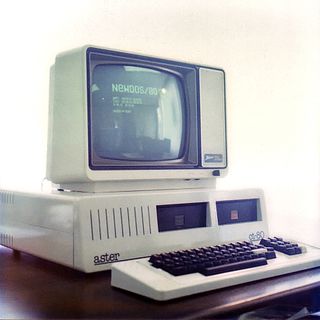
The Aster CT-80 is a 1982 personal computer developed by the small Dutch company MCP, was sold in its first incarnation as a kit for hobbyists. Later it was sold ready to use. It consisted of several Eurocard PCB's with DIN 41612 connectors, and a backplane all based on a 19-inch rack configuration. It was the first commercially available Dutch personal/home computer. The Aster computer could use the software written for the popular Tandy TRS-80 computer while fixing many of the problems of that computer, but it could also run CP/M software, with a large amount of free memory Transient Program Area, (TPA) and a full 80×25 display, and it could be used as a Videotext terminal. Although the Aster was a clone of the TRS-80 Model I it was in fact more compatible with the TRS-80 Model III and ran all the software of these systems including games. It also had a built-in speaker which was compatible with such games software.

Amstrad was a British consumer electronics company, founded in 1968 by Alan Sugar. During the 1980s, the company was known for its home computers beginning with the Amstrad CPC and later also the ZX Spectrum range after the Sinclair deal, which led it to have a substantial share of the PC market in Britain. In the following decade it shifted focus towards communication technologies, and its main business during the 2000s was the manufacture of satellite television set-top boxes for Sky, which Amstrad had started in 1989 as the then sole supplier of the emerging Sky TV service.

The Tandy 1000 is the first in a line of IBM PC compatible home computer systems produced by the Tandy Corporation for sale in its Radio Shack and Radio Shack Computer Center chains of stores. Introduced in 1984, the product line was aimed at providing affordable but capable systems for home computing or education, with some of its Tandy specific features like graphics, sound and joystick port making it more appealing for home use.
The Sprinter is a microcomputer made by the Russian firm Peters Plus, Ltd. It was the last ZX Spectrum clone produced in a factory.
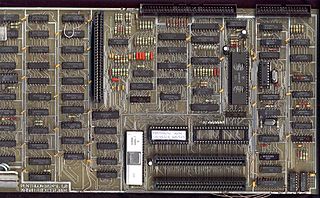
The Pentagon home computer was a clone of the British-made Sinclair ZX Spectrum 128. It was manufactured by amateurs in the former Soviet Union, following freely distributable documentation. Its PCB was copied all over the ex-USSR in 1991-1996, which made it a widespread ZX Spectrum clone. The name "Pentagon" derives from the shape of the original PCB, with a diagonal cut in one of the corners.

The SAM Coupé is an 8-bit British home computer manufactured by Miles Gordon Technology (MGT), based in Swansea in the United Kingdom and released in December 1989.
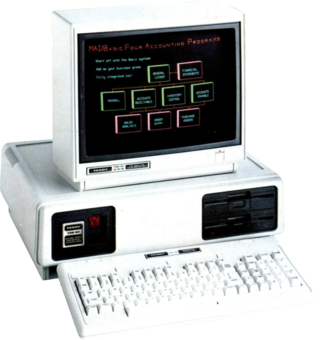
The Tandy 2000 is a personal computer introduced by Radio Shack in September 1983 based on the 8 MHz Intel 80186 microprocessor running MS-DOS. By comparison, the IBM PC XT used the older 4.77 MHz Intel 8088 processor, and the IBM PC/AT would later use the newer 6 MHz Intel 80286. Due to the 16-bit data bus and more efficient instruction decoding of the 80186, the Tandy 2000 ran significantly faster than other PC compatibles, and slightly faster than the PC AT. The Tandy 2000 was the company's first computer built around an Intel x86 series microprocessor; previous models used the Zilog Z80 and Motorola 6809 CPUs.

The X68000 is a home computer created by Sharp Corporation. It was first released in 1987 and sold only in Japan.

The FM Towns is a Japanese personal computer built by Fujitsu from February 1989 to the summer of 1997. It started as a proprietary PC variant intended for multimedia applications and PC games, but later became more compatible with IBM PC compatibles. In 1993, the FM Towns Marty was released, a game console compatible with existing FM Towns games.

The FM Towns Marty is a home video game console released in 1993 by Fujitsu, exclusively for the Japanese market. It is often claimed to be the first 32-bit CD-based home video game system, although it has a 16-bit data bus, like the earlier Commodore CDTV and Sega CD, which both have Motorola 68000 processors that are internally 16/32-bit, but with a 16-bit data bus. The console comes with a built-in CD-ROM drive and disk drive. It was based on the earlier FM Towns computer system Fujitsu had released in 1989. The Marty was backward-compatible with older FM Towns games.

The Macintosh Quadra 950 is a personal computer designed, manufactured and sold by Apple Computer from March 1992 to October 1995. It replaced the Quadra 900 that was introduced several months earlier, increasing the CPU clock rate of its 68040 CPU from 25 MHz to 33 MHz, and improving the graphics support. The two computers were otherwise identical, including the price. With a Macintosh Processor Upgrade Card installed, this computer is known as the Power Macintosh 950.

The Rainbow 100 is a microcomputer introduced by Digital Equipment Corporation (DEC) in 1982. This desktop unit had a monitor similar to the VT220 and a dual-CPU box with both 4 MHz Zilog Z80 and 4.81 MHz Intel 8088 CPUs. The Rainbow 100 was a triple-use machine: VT100 mode, 8-bit CP/M mode, and CP/M-86 or MS-DOS mode using the 8088. It ultimately failed to in the marketplace which became dominated by the simpler IBM PC and its clones which established the industry standard as compatibility with CP/M became less important than IBM PC compatibility. Writer David Ahl called it a disastrous foray into the personal computer market. The Rainbow was launched along with the similarly packaged DEC Professional and DECmate II which were also not successful. The failure of DEC to gain a significant foothold in the high-volume PC market would be the beginning of the end of the computer hardware industry in New England, as nearly all computer companies located there were focused on minicomputers for large organizations, from DEC to Data General, Wang, Prime, Computervision, Honeywell, and Symbolics Inc.

The ATM Turbo, also known simply as ATM is a ZX Spectrum clone, developed in Moscow in 1991, by two firms, MicroArt and ATM.
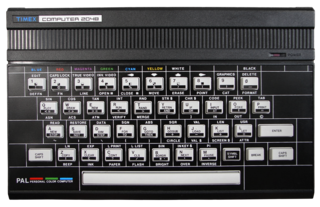
The Timex Computer 2048 or TC 2048 is a 1984 computer developed by Timex Portugal, at the time part of Timex Sinclair. It was based on the Timex Sinclair 2048 prototype, with a similar redesign case, composite video output, Kempston joystick interface, and additional video modes, while being highly compatible with the Sinclair ZX Spectrum computer.
iS-DOS is a disk operating system (DOS) for Soviet/Russian ZX Spectrum clones. iS-DOS was developed in 1990 or 1991, by Iskra Soft, in Leningrad, Soviet Union, now Saint Petersburg, Russia.

The Power Macintosh 5500 is a personal computer designed, manufactured, and sold by Apple Computer from February 1997 to March 1998. Like the Power Macintosh 5260 and 5400 that preceded it, the 5500 is an all-in-one design, built around a PowerPC 603ev processor operating at 225, 250 or 275 megahertz (MHz).
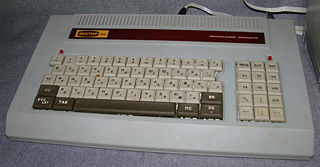
Vector-06C is a home computer with unique graphics capabilities that was designed and mass-produced in USSR in the late 1980s.
The Commodore PC compatible systems are a range of IBM PC compatible personal computers introduced in 1984 by home computer manufacturer Commodore Business Machines.

The Scorpion ZS-256 was a very widespread ZX Spectrum clone produced in St. Petersburg by Sergey Zonov.
References
- ↑ "KAY Nemo Documentation". speccy4ever.
- ↑ KAY 1024 Schematic (PDF). NEMO. 2000.
- ↑ Szczepaniak, John (April 2005). "Global Gaming". Retro Gamer. Vol. 2, no. 3. pp. 78–80.
- ↑ ZpiXel; GFXZone (January 2002). "ZX-Spectrum graphics modes". ZpiXel ZX Spectrum Scene Graphics.
- 1 2 "KAY-1024". ZX - Spectrum REAL HARDWARE MUST LIVE !.
- ↑ "KAY 1024. Руководство по эксплуатации". ZXPRESS — Журналы, газеты и книги для ZX Spectrum.
- ↑ Nemo. "ZX Spectrum demo Kay 1024 Information". AAA presents: ZX Spectrum Demos.
- 1 2 3 4 5 "Sinclair – Nachbauten". 8Bit-Museum.de. Retrieved 2022-12-30.
- ↑ "KAY". SpeccyWiki. Retrieved 2023-01-30.
- 1 2 "KAY-2010". SpeccyWiki. Retrieved 2023-01-30.
